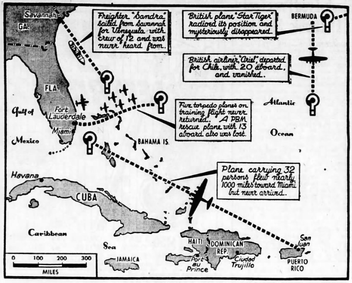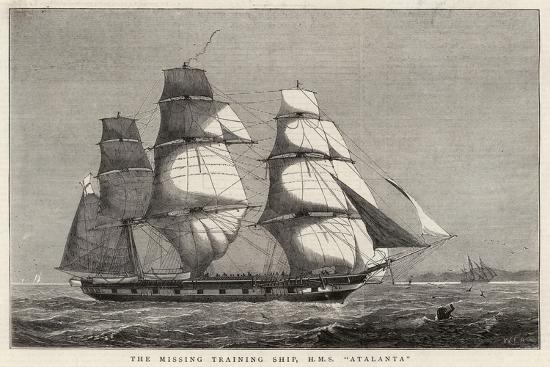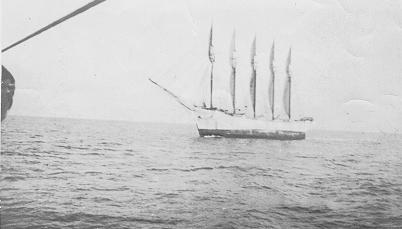The Bermuda Triangle, sometimes referred to as the Devil’s Triangle, is a legendary area in the western North Atlantic Ocean. This region is infamous for the alleged disappearances of various aircraft and ships under mysterious conditions. The concept of this area being particularly prone to such vanishings gained popularity in the mid-20th century. However, most credible sources reject the notion that there is anything unusual or mysterious about these occurrences.

Devil’s Triangle
One version of the Bermuda Triangle area
Origins
The earliest mention of unusual disappearances in the Bermuda Triangle appeared in an article by Edward Van Winkle Jones of the Miami Herald, which was distributed by the Associated Press and published in various American newspapers on September 17, 1950.
Two years later, a short article titled “Sea Mystery at Our Back Door” by George X. Sand was published in Fate magazine. This piece was the first to outline the now-recognized triangular area where these mysterious losses supposedly occurred. Sand recounted several incidents of planes and ships disappearing since World War II: the Sandra, a tramp steamer; the loss of Flight 19, a group of five US Navy torpedo bombers on a training mission in December 1945; the disappearance of the Star Tiger, a British South American Airways (BSAA) passenger airplane in January 1948; a fishing skiff with three men, including jockey Albert Snider, in March 1948; the loss of an Airborne Transport DC-3 charter flight en route from Puerto Rico to Miami in December 1948; and the disappearance of another BSAA passenger airplane, the Star Ariel, in January 1949.

Flight 19 was revisited in the April 1962 issue of The American Legion Magazine. Author Allan W. Eckert wrote that the flight leader had been heard saying, “We cannot be sure of any direction… everything is wrong… strange… the ocean doesn’t look as it should.” In February 1964, Vincent Gaddis wrote an article for Argosy titled “The Deadly Bermuda Triangle,” claiming that Flight 19 and other disappearances were part of a pattern of strange events in the region, dating back to at least 1840. Gaddis expanded this article into a book, “Invisible Horizons,” the following year.
Other writers built upon Gaddis’ ideas, including John Wallace Spencer with “Limbo of the Lost” (1969, repr. 1973), Charles Berlitz with “The Bermuda Triangle” (1974), and Richard Winer with “The Devil’s Triangle” (1974). Many of these authors incorporated supernatural elements into their works.
Triangle Area

Description
Map published with an Associated Press article on September 17, 1950
Author or
copyright owner
Associated Press
Source (WP:NFCC#4)
https://www.newspapers.com/article/battle-creek-enquirer-unsolved-disappear/137797249/
In his article for Fate magazine, Sand described the Bermuda Triangle as “a watery triangle bounded roughly by Florida, Bermuda, and Puerto Rico.” Gaddis, in his Argosy article, further defined the boundaries by specifying the vertices as Miami; San Juan, Puerto Rico; and Bermuda. However, later writers did not consistently adhere to this definition. Various authors proposed different boundaries and vertices for the triangle, causing the total area to range from 1.3 to 3.9 million km² (0.50 to 1.51 million sq mi). Some even extended the triangle’s reach as far as the coast of Ireland. Consequently, whether a particular incident is considered to have occurred within the Bermuda Triangle depends largely on which writer is reporting it.
Criticism of the Concept
Larry Kusche
Larry Kusche, in his book “The Bermuda Triangle Mystery: Solved” (1975), argued that many claims by Gaddis and subsequent writers were exaggerated, dubious, or unverifiable. Kusche’s research uncovered numerous inaccuracies and inconsistencies between Berlitz’s accounts and statements from eyewitnesses, participants, and others involved in the original incidents. He highlighted instances where important information was omitted, such as the case of round-the-world yachtsman Donald Crowhurst, whom Berlitz presented as a mysterious disappearance despite clear evidence to the contrary. Another example involved an ore carrier that Berlitz claimed disappeared without a trace three days out of an Atlantic port, whereas it had actually been lost three days out of a port with the same name in the Pacific Ocean. Kusche also pointed out that many incidents attributed to the Triangle’s mysterious influence actually occurred outside its boundaries. Often, his research was straightforward: he would examine period newspapers for the dates of reported incidents and find relevant reports, such as unusual weather conditions, that were never mentioned in the disappearance stories.
Kusche concluded that:
- The number of ships and aircraft reported missing in the area was not significantly greater, proportionally speaking, than in any other part of the ocean.
- In an area prone to tropical cyclones, the number of disappearances was not disproportionate, unlikely, or mysterious.
- Berlitz and other writers often failed to mention such storms or misrepresented the disappearances as occurring in calm conditions when meteorological records clearly contradicted this.
- The numbers were exaggerated due to sloppy research. For example, a boat’s disappearance might be reported, but its eventual return to port might not be.
- Some disappearances had never happened. For instance, a plane crash supposedly occurring in 1937 off Daytona Beach, Florida, in front of hundreds of witnesses, was fabricated.
- The legend of the Bermuda Triangle is a manufactured mystery, perpetuated by writers using misconceptions, faulty reasoning, and sensationalism.
Further Responses
During the production of the British Channel 4 television program “The Bermuda Triangle” (1992) for the Equinox series by John Simmons of Geofilms, the marine insurance market Lloyd’s of London was asked if an unusually large number of ships had sunk in the Bermuda Triangle area. Lloyd’s determined that large numbers of ships had not sunk there, and they do not charge higher rates for passing through this area. United States Coast Guard records support this conclusion, noting that the number of supposed disappearances is relatively insignificant considering the volume of traffic through the area.
The Coast Guard is also officially skeptical of the Triangle, as their inquiries often contradict many of the incidents written about by Triangle authors. For instance, in the 1972 explosion and sinking of the tanker V. A. Fogg, the Coast Guard photographed the wreck and recovered several bodies, countering a Triangle author’s claim that all the bodies had vanished except for the captain, who was allegedly found clutching a coffee cup in his cabin. Additionally, the V. A. Fogg sank off the coast of Texas, far from the Triangle’s commonly accepted boundaries.
The Nova/Horizon episode “The Case of the Bermuda Triangle,” aired on June 27, 1976, was highly critical, stating that “When we’ve gone back to the original sources or the people involved, the mystery evaporates. Science does not have to answer questions about the Triangle because those questions are not valid in the first place… Ships and planes behave in the Triangle the same way they behave everywhere else in the world.”
Skeptical researchers like Ernest Taves and Barry Singer have noted that mysteries and the paranormal are very popular and profitable, leading to the production of vast amounts of material on topics like the Bermuda Triangle. They demonstrated that some pro-paranormal material is often misleading or inaccurate, yet its producers continue to market it. Consequently, they argued that the market is biased in favor of media that support the Triangle mystery and against well-researched material that espouses a skeptical viewpoint.
In a 2013 study, the World Wide Fund for Nature identified the world’s ten most dangerous waters for shipping, but the Bermuda Triangle was not among them.
Benjamin Radford, an author and scientific paranormal investigator, noted in an interview about the Bermuda Triangle that locating an aircraft lost at sea can be very difficult due to the vast search area. While the disappearance might be mysterious, it is not necessarily paranormal or unexplainable. Radford emphasized the importance of double-checking information, pointing out that the Bermuda Triangle mystery was created by people who neglected to do so.
Hypothetical Explanation Attempts
Paranormal Explanations
Proponents of the Bermuda Triangle as a real phenomenon have suggested various supernatural explanations. One theory attributes the mysterious events to remnants of advanced technology from the mythical lost continent of Atlantis. This idea is sometimes linked to the Bimini Road, a submerged rock formation near Bimini in the Bahamas, which some definitions place within the Triangle. Followers of the psychic Edgar Cayce believe his prediction that evidence of Atlantis would be found in 1968 refers to the discovery of the Bimini Road. While believers describe this formation as a road, wall, or other structure, it is of natural origin.
Another hypothesis suggests the existence of a parallel universe within the Bermuda Triangle, causing a time/space warp that draws objects into an alternate reality. Some theories also attribute the events to UFO activity. Charles Berlitz, who authored several books on anomalous phenomena, presents multiple theories that attribute the losses in the Triangle to mysterious or unexplained forces.
Natural Explanations
Compass Variations
Compass problems are frequently cited in many Bermuda Triangle incidents. Some theories suggest that unusual local magnetic anomalies might exist in the area, although such anomalies have not been found. Navigators have long been aware that compasses have natural magnetic variations in relation to the magnetic poles. Magnetic (compass) north and geographic (true) north align only in a few places; in the United States, as of 2000, this alignment occurs along a line running from Wisconsin to the Gulf of Mexico. The general public may not be as informed about this, leading to misconceptions about the mysterious behavior of compasses “changing” across an area as large as the Triangle, which is a natural occurrence.
Gulf Stream
The Gulf Stream, also known as the Florida Current, is a significant surface current driven primarily by thermohaline circulation. It originates in the Gulf of Mexico and flows through the Straits of Florida into the North Atlantic. Essentially, it acts as a river within the ocean, capable of carrying floating objects along its path. The Gulf Stream has a maximum surface velocity of about 2 meters per second (6.6 feet per second). This current can quickly carry away a small plane making a water landing or a boat experiencing engine trouble, moving it far from its reported position.
Human Error
Human error is one of the most frequently cited explanations in official investigations into the loss of aircraft or vessels. For instance, human stubbornness may have led businessman Harvey Conover to lose his sailing yacht, the Revonoc, when he sailed into a storm south of Florida on January 1, 1958.
Violent Weather

Hurricanes, which are powerful storms forming in tropical waters, have historically claimed thousands of lives and caused billions of dollars in damage. The first recorded instance of a destructive hurricane was the sinking of Francisco de Bobadilla’s Spanish fleet in 1502. These storms have contributed to several incidents associated with the Bermuda Triangle. Many Atlantic hurricanes pass through the Triangle as they curve off the Eastern Seaboard, and before the advent of weather satellites, ships often had little to no warning of an approaching hurricane.
A powerful downdraft of cold air was suspected to have caused the sinking of the Pride of Baltimore on May 14, 1986. The crew reported that the wind suddenly shifted and its velocity increased from 32 km/h (20 mph) to 97–145 km/h (60–90 mph). National Hurricane Center satellite specialist James Lushine explained that “during very unstable weather conditions, the downburst of cold air from aloft can hit the surface like a bomb, exploding outward like a giant squall line of wind and water.”
Methane Hydrates
Source: United States Geological Survey
One explanation for some of the disappearances in the Bermuda Triangle involves large fields of methane hydrates (a form of natural gas) found on the continental shelves. Laboratory experiments conducted in Australia have demonstrated that bubbles can sink a scale model ship by reducing the water’s density. Any wreckage would likely be deposited on the ocean floor or quickly dispersed by the Gulf Stream. It is hypothesized that periodic methane eruptions, sometimes referred to as “mud volcanoes,” could create regions of frothy water that lack sufficient buoyancy to support ships. If a ship were to encounter such an area, it could potentially sink rapidly and without warning.
Publications by the US Geological Survey (USGS) describe extensive undersea hydrate deposits worldwide, including in the Blake Ridge area off the southeastern coast of the United States. However, the USGS indicates that no significant releases of gas hydrates are believed to have occurred in the Bermuda Triangle in the past 15,000 years.
Notable Incidents
HMS Atalanta

The sail training ship HMS Atalanta, originally named HMS Juno, vanished with her entire crew after departing from the Royal Naval Dockyard in Bermuda bound for Falmouth, England, on January 31, 1880. It is believed she sank during a powerful storm that crossed her route a few weeks after she set sail. The fact that her crew consisted primarily of inexperienced trainees may have been a contributing factor. The search for evidence of her fate attracted worldwide attention at the time. The connection is often made to the 1878 loss of the training ship HMS Eurydice, which foundered after leaving the Royal Naval Dockyard in Bermuda for Portsmouth on March 6. Decades later, HMS Atalanta was alleged to have been a victim of the mysterious Bermuda Triangle. However, this allegation was thoroughly refuted by the research of author David Francis Raine in 1997.
USS Cyclops
The single largest loss of life in the history of the US Navy unrelated to combat occurred when the collier USS Cyclops went missing without a trace. Carrying a full load of manganese ore and with one engine out of action, Cyclops disappeared sometime after March 4, 1918, after departing from the island of Barbados. While there is no strong evidence supporting any single theory, various independent theories have been proposed, including storms, capsizing, and wartime enemy activity.
Additionally, two of Cyclops’s sister ships, Proteus and Nereus, were lost in the North Atlantic during World War II. Both vessels were transporting heavy loads of metallic ore similar to the cargo carried by Cyclops on her fatal voyage. In all three cases, structural failure due to overloading with a much denser cargo than the ships were designed to carry is considered the most likely cause of the sinkings.
Carroll A. Deering

The Carroll A. Deering, a five-masted schooner built in 1919, was discovered hard aground and abandoned at Diamond Shoals near Cape Hatteras, North Carolina, on January 31, 1921. An FBI investigation into the Deering thoroughly examined and dismissed multiple theories regarding why and how the ship was abandoned. These theories included piracy, domestic Communist sabotage, and involvement with rum-runners.
Flight 19
Flight 19 was a training flight consisting of five TBM Avenger torpedo bombers that disappeared on December 5, 1945, while flying over the Atlantic Ocean. The squadron’s planned flight path was to take them due east from Fort Lauderdale for 141 miles (227 km), then north for 73 miles (117 km), and finally east again over a 140-mile (225 km) leg to complete the exercise. However, the flight failed to return to base. Navy investigators attributed the disappearance to navigational errors that led the aircraft to run out of fuel.
During the search and rescue operation, a PBM Mariner aircraft with a crew of 13 was deployed but also disappeared. A tanker off the coast of Florida reported witnessing an explosion and observing a large oil slick while searching for survivors. The weather conditions were deteriorating towards the end of the incident. According to reports at the time, the Mariner aircraft had a history of explosions caused by vapor leaks when heavily loaded with fuel, as it likely was during the extensive search-and-rescue mission.
Star Tiger and Star Ariel
BSAA Star Tiger Disappearance
G-AHNP Star Tiger disappeared on January 30, 1948, during a flight from the Azores to Bermuda. Operated by British South American Airways (BSAA), Star Tiger was an Avro Tudor IV passenger aircraft. The flight vanished under circumstances that remain a mystery to this day. The aircraft was operating near the limits of its range, and any minor error or equipment malfunction could have prevented it from reaching its destination.
BSAA Star Ariel Disappearance
G-AGRE Star Ariel disappeared on January 17, 1949, while on a flight from Bermuda to Kingston, Jamaica. Like Star Tiger, Star Ariel was also an Avro Tudor IV aircraft operated by BSAA. It disappeared without a trace, similarly operating at the very edge of its range. The disappearance of both Star Tiger and Star Ariel has puzzled investigators and sparked numerous theories, yet no conclusive explanation has ever been determined.
Douglas DC-3
1948 Airborne Transport DC-3 Disappearance
On December 28, 1948, a Douglas DC-3 aircraft with registration number NC16002 disappeared during a flight from San Juan, Puerto Rico, to Miami. The aircraft vanished without leaving any trace, along with all 32 people on board. A Civil Aeronautics Board investigation failed to determine the probable cause of the disappearance due to insufficient available information.
Connemara IV
A pleasure yacht named Connemara IV was discovered adrift in the Atlantic Ocean south of Bermuda on September 26, 1955. According to accounts by authors like Berlitz and Winer, the crew of Connemara IV supposedly vanished, although the yacht survived being at sea during three hurricanes. Records from the 1955 Atlantic hurricane season indicate that Hurricane Ione passed nearby between September 14 and 18, affecting Bermuda with almost gale-force winds. Winer quoted a letter from Mr. J.E. Challenor of Barbados describing the yacht’s owner’s account of the events leading to its disappearance due to dragged moorings during Hurricane Janet.
KC-135 Stratotankers
On August 28, 1963, two US Air Force KC-135 Stratotanker aircraft collided and crashed into the Atlantic Ocean 300 miles (480 km) west of Bermuda. Some sources suggest there were two distinct crash sites separated by over 160 miles (260 km) of water, but Larry Kusche’s research indicated otherwise. The unclassified version of the Air Force investigation report revealed that the debris field defining the second “crash site” was actually seaweed and driftwood tangled with an old buoy, not wreckage from a second aircraft collision.
Latest Updates







 Let’s imagine, explore, and uncover the mysteries together!
Let’s imagine, explore, and uncover the mysteries together!